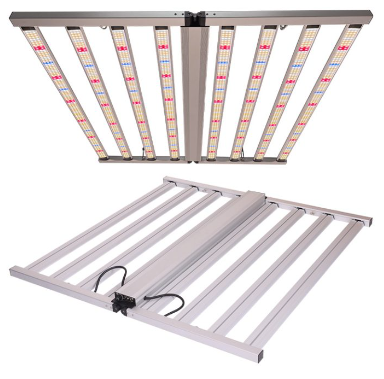Introduction
Nitrogen is vital for healthy plant growth, promoting lush foliage and optimizing photosynthesis. As one of the essential macronutrients, nitrogen plays a crucial role in various plant functions. To maximize your plants’ potential, understanding how to add nitrogen to your soil is essential. This guide not only covers effective nitrogen addition methods but also emphasizes how proper plant growth lighting can amplify these benefits. By combining the right soil practices with advanced lighting techniques, you can ensure your plants thrive and reach their full potential.
Understanding the Importance of Nitrogen for Plant Health
Plants require nitrogen for several key reasons:
- Chlorophyll Production: Nitrogen is essential for chlorophyll, the green pigment in plants that allows them to photosynthesize effectively. Without adequate nitrogen, plants may exhibit yellowing leaves and stunted growth.
- Protein Synthesis: As a core component of amino acids, nitrogen supports protein production, which is vital for building and repairing plant tissues. Proteins are essential for enzymatic functions and overall plant metabolism.
- Leaf Growth and Vigor: Adequate nitrogen leads to vigorous growth, especially beneficial for leafy greens and grasses. This nutrient is particularly important for crops like lettuce, spinach, and kale, where leaf production is key.
- Genetic Integrity: Nitrogen helps maintain nucleic acids like DNA and RNA, which guide plant growth and reproduction. A strong genetic foundation is essential for producing healthy seeds and fruits.
Effective Methods to Add Nitrogen to Soil
Adding nitrogen can be accomplished through both organic and synthetic methods. Here’s how to enhance your soil effectively:
1. Compost
Mixing compost into your soil provides a slow-release nitrogen source while enriching soil health with beneficial microbes. Compost not only improves soil structure but also enhances its ability to retain moisture and nutrients.
2. Animal Manure
Using chicken or cow manure as a potent nitrogen source can significantly boost your soil’s nutrient content. Proper application and composting of manure can lead to enhanced plant growth while minimizing the risk of pathogen transfer.
3. Fish Emulsion
Fish emulsion is a quick-acting organic fertilizer that boosts nitrogen levels immediately. Pairing it with appropriate lighting can enhance nutrient uptake, ensuring that plants benefit from the added nitrogen quickly.
4. Blood Meal
As a concentrated nitrogen source, blood meal should be applied carefully to avoid attracting pets. This fast-release nitrogen source can be particularly effective for leafy crops and should be used in moderation.
5. Coffee Grounds
An easy-to-source nitrogen addition, coffee grounds can be mixed into the soil to improve its structure and nutrient content. They also provide additional organic matter, which enhances soil fertility.
6. Legumes
Incorporating legumes into your crop rotation can naturally fix atmospheric nitrogen, enhancing soil fertility. Plants like clover and peas form symbiotic relationships with nitrogen-fixing bacteria, making them excellent cover crops.
7. Grass Clippings
Using dried grass clippings can provide nitrogen while retaining moisture and suppressing weeds. This method is particularly useful in mulching, creating a nutrient-rich layer that decomposes slowly.
8. Alfalfa Meal
Alfalfa meal is an organic amendment rich in nitrogen and can also provide trace minerals. It’s an excellent choice for boosting nitrogen levels, especially in vegetable gardens.
9. Seaweed Fertilizer
Seaweed fertilizer not only provides nitrogen but also contains trace elements and growth hormones that promote overall plant health. When combined with proper lighting, seaweed can enhance growth significantly.
10. Ammonium Nitrate
As a fast-acting synthetic nitrogen source, ammonium nitrate can quickly improve plant vigor. It’s important to apply it carefully, as excessive use can lead to nutrient burn.
11. Nitrogen-Rich Fertilizer Mixes
These mixes are designed for concentrated nitrogen delivery and are essential for enhancing growth, especially under suitable lighting conditions. Look for blends that include slow-release options for long-term benefits.
The Interplay Between Nitrogen and Plant Growth Lighting
While adding nitrogen to your soil is crucial, the right plant growth lighting can amplify these efforts. Here’s how lighting interacts with nitrogen levels and plant growth:
1. Enhanced Photosynthesis
Proper lighting is essential for photosynthesis, the process by which plants convert light energy into chemical energy. High-quality LED grow lights can provide the optimal light spectrum that promotes chlorophyll production, enhancing the effectiveness of nitrogen in plant growth.
2. Accelerated Growth Cycles
With the right light conditions, plants can experience accelerated growth cycles. When nitrogen levels are adequate, combined with the appropriate light intensity and spectrum, plants can develop more robustly and efficiently, leading to quicker harvests.
3. Light Spectrum Considerations
Different growth stages require different light spectra. During the vegetative stage, blue light (400-500 nm) supports leaf growth and overall vigor. In contrast, red light (600-700 nm) is vital during the flowering stage, enhancing bud development. Understanding these requirements helps growers tailor their lighting setups to maximize nitrogen uptake and plant health.
4. Stress Reduction
Proper lighting can reduce plant stress, enabling them to utilize nitrogen more effectively. Stress-free plants are better able to absorb nutrients and grow, leading to improved yields and quality.
 Conclusion
Conclusion
To truly maximize your plants’ growth potential, combining effective nitrogen addition techniques with high-quality plant growth lights is key. The right lighting enhances photosynthesis, making your nitrogen efforts more effective. Understanding the interplay between nitrogen and lighting allows you to create an optimal environment for your plants, leading to healthier growth and bountiful harvests.
By investing in advanced plant growth lighting technology, such as full-spectrum LED grow lights, you can ensure that your plants receive the light they need to thrive. This combination of good soil management and appropriate lighting will help you achieve the lush, vigorous plants you desire.
Call to Action
Ready to boost your plants’ growth with the right nitrogen strategies and lighting? Follow our blog for the latest insights on soil management, plant growth lighting technologies, and practical gardening tips. Whether you’re a novice gardener or an experienced grower, we have the resources you need to succeed!

































